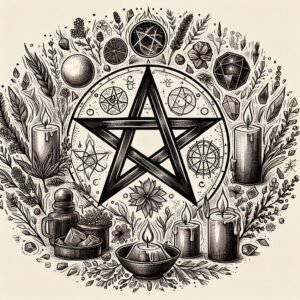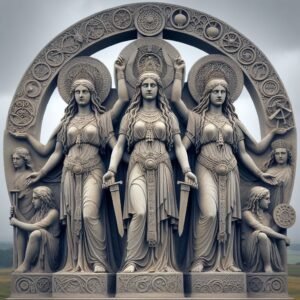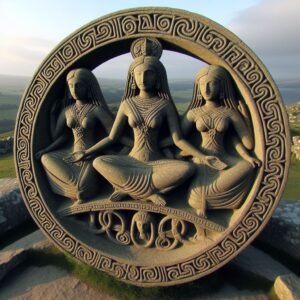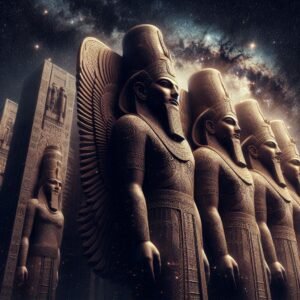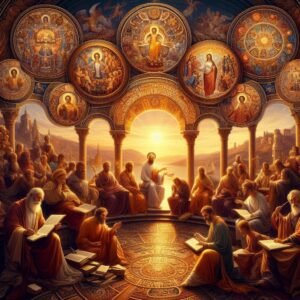
Neith is an ancient Egyptian deity revered as the creator and a goddess of war, hunting, and weaving. Her origins trace back to the pre-dynastic period, making her one of the oldest deities in the Egyptian pantheon. Often depicted wielding a bow and arrows, Neith was associated with the Red Crown of Lower Egypt and was the patron deity of the city of Sais in the western Nile Delta. She was considered a primeval creator goddess who created the universe and its inhabitants, governing their functions and embodying the concepts of wisdom and fate.
Neith’s iconography often includes the ankh, symbolizing life, and the was-scepter, indicating power. In art, she is shown as a fierce protector, sometimes with a loom, highlighting her association with weaving, which was metaphorically linked to the creation of the world. Neith was also connected to water and rivers, further emphasizing her role as a life-giver and sustainer. Her worship persisted throughout Egypt’s history, reflecting her significance and multifaceted nature within the Egyptian religious framework.

The Egyptian pantheon
The pantheon of ancient Egyptian deities is vast and diverse, encompassing a multitude of gods and goddesses with various roles and attributes. Among the most prominent is Amun, the king of the gods, often merged with the sun god Ra to become Amun-Ra, symbolizing ultimate power and creation. Isis, the goddess of magic and motherhood, is renowned for her wisdom and protective qualities, particularly in her role in the myth of Osiris, her husband, who is the god of the afterlife and resurrection. Horus, their son, is a sky deity whose eyes represent the sun and the moon.
Thoth, the god of writing and knowledge, is depicted with the head of an ibis and is associated with the moon and the reckoning of time. Anubis, the jackal-headed god, presides over funerary rites and the embalming process. Hathor, the cow goddess, embodies motherhood, fertility, and music, and is often depicted as a nurturing figure. Sekhmet, the lioness, represents the fierce aspect of the sun’s heat and is a warrior goddess as well as a healer.
Set, the god of chaos, storms, and the desert, is often portrayed as the antagonist in Egyptian mythology, particularly in the conflict with his brother Osiris and nephew Horus. Bastet, initially a lioness warrior like Sekhmet, evolved into a goddess of home, fertility, and childbirth, often depicted as a domestic cat. Sobek, the crocodile god, is associated with the Nile’s fertility as well as its dangers, embodying the duality of nature.
Other notable deities include Ptah, the god of craftsmen and architects, who is believed to have created the world through his heart and words. Ma’at, the goddess of truth, justice, and cosmic order, is depicted with an ostrich feather and is integral to the concept of balance and order in Egyptian society. Osiris’s sister and wife, Isis, is revered for her magical skills and dedication to her husband, playing a crucial role in his resurrection and the subsequent birth of their son, Horus.
Lesser-known but equally fascinating gods include Khonsu, the moon god; Anhur, a war and hunting god; and Seshat, the goddess of writing and measurement. Each deity has a rich mythology and significance, contributing to the complex tapestry of ancient Egyptian belief systems that have fascinated scholars and laypeople alike for centuries. The reverence for these deities is evident in the grand temples and monuments erected in their honour, the intricate rituals performed to appease them, and the enduring stories that have been passed down through millennia. The ancient Egyptians’ world was imbued with the divine, and their gods and goddesses played a central role in the natural and social order of their universe.

The creation myths
In Egyptian mythology, the creation myth is a wide collection of stories and symbolism, reflecting the ancient Egyptians’ deep connection to the cosmos and their quest to understand the origins of existence. The most prominent creation myths arose from Heliopolis, Memphis, and Hermopolis, each presenting a unique perspective on the universe’s inception.
The Heliopolitan creation myth centres on the sun god Ra, who emerged from the primordial waters of chaos, called Nu. From Ra or Atum, the first gods, Shu (air) and Tefnut (moisture), were born, leading to the creation of Geb (earth) and Nut (sky), who in turn bore Osiris, Isis, Set, and Nephthys. This narrative intertwines with the Osiris myth, linking the ideology of kingship with the cosmos’ creation.
In Memphis, the god Ptah was the chief deity, and the creation was said to be conceived in his heart and spoken into existence by his tongue, emphasizing the power of words and thoughts. The Memphite theology presents Ptah as the creator of everything, including the other gods through his heart and speech.
The Hermopolitan myth introduces the Ogdoad, a group of eight primordial deities representing the fundamental elements of creation. They existed in the form of four male and female pairs, embodying the principles of invisibility, darkness, infinity, and hiddenness. Their interplay resulted in the emergence of the primeval hill and the subsequent creation of the rest of the gods and the world.
Common to these myths is the motif of the primeval waters of chaos and the emergence of a primeval mound, the benben, from which life sprang. This imagery likely drew inspiration from the annual flooding of the Nile, which left behind fertile soil, akin to life emerging from chaos. The sun, a vital element in Egyptian mythology, first rose from this mound, symbolizing the dawn of creation.
The creation myths also include the notion of Zep Tepi, “the first occasion,” when time began and the gods set the order of the universe. This concept allowed the Egyptians to explain the cyclical nature of life and the renewal processes observed in their environment, such as the daily journey of the sun and the seasonal flooding of the Nile.
These myths were not mutually exclusive but rather coexisted, offering different facets of the Egyptians’ understanding of creation. They provided a framework for the Egyptians to interpret their world, where the divine was intimately intertwined with the natural and social order, and where the gods actively participated in the maintenance of the universe’s balance.

The Goddess Neith and the creation myths
Neith holds a significant place in Egyptian creation myths. As a primeval deity, she is often depicted as the creator of the universe, a role that underscores her immense power and wisdom. In various narratives, Neith is described as self-generated, and her attributes extend to the very fabric of existence. She is the weaver of the cosmos, metaphorically crafting the world with her loom, which represents the intertwining of fate and the passage of time. Her connection to water and the primordial chaos from which the world emerged aligns her with the life-giving forces of creation.
Neith, in various ancient traditions, is revered as a deity of unparalleled might and mystery, often depicted as the creator of the universe and all that resides within it. Her association with Ra, the sun god, is particularly significant, as she is believed to be his mother, thus placing her at the very heart of the cosmic order. The imagery of Neith rebirthing Ra each morning is a powerful symbol of renewal and continuity, representing the dawn as a daily act of creation that mirrors the original creation of the world.
This concept of perpetual creation is central to Neith’s mythology. She is not only the mother of the sun but also the weaver of the cosmos, intertwining the destinies of gods and mortals alike. Her loom is said to be the fabric of reality itself, with each thread representing the life of a being or the course of an event. As such, Neith’s role transcends mere motherhood; she is the architect of existence, the original source from which all life springs and to which it inevitably returns.
The daily emergence of Ra, under Neith’s maternal auspices, is a moment of profound significance. It is a miniature echo of the first sunrise, which brought warmth and illumination to the primordial darkness. This act of daily rebirth is a testament to Neith’s enduring influence, a reminder that the cycles of life, death, and rebirth are forever in her hands. It is as if each new day is a canvas upon which Neith paints with the radiant colours of the dawn, a masterpiece of light that banishes the shadows of night.
Moreover, Neith’s connection to the sun and the process of creation is deeply symbolic of the human condition. Just as Ra’s journey across the sky represents the passage of time, so too does Neith’s role in his rebirth reflect the human capacity for renewal and resilience. In the face of adversity and the passage of time, humanity, much like the sun, has the potential to rise anew, invigorated by the promise of a fresh start.
In essence, Neith’s mythology serves as a metaphor for the boundless potential of creation and the enduring nature of life itself. Her story is a narrative of hope, a declaration that no matter the darkness, light will always return. It is a universal truth that resonates across cultures and ages, a truth that is as relevant today as it was in the time of the ancients. Neith, as the mother of Ra and the weaver of fate, stands as an eternal testament to the power of beginning anew, of the relentless march of days, and of the indomitable spirit that defines the very essence of life.
Her iconography, featuring the Red Crown of Lower Egypt and the crossed arrows and shield, not only signifies her martial prowess but also her protective nature over the cosmos and the pharaohs. As a guardian deity, Neith’s influence extends from the celestial to the terrestrial and even into the underworld, where she is seen as a protector of Duamutef, one of the sons of Horus.
Neith’s presence in creation myths embodies the ancient Egyptians’ understanding of the interconnectedness of life, death, and rebirth. Her role transcends the mere act of creation; it encompasses the ongoing cycle of life, the maintenance of cosmic order, and the imparting of wisdom to the rulers of Egypt. Her worship at Sais, her cult centre, was a testament to her enduring significance, and her mythology continues to intrigue and inspire those who study the rich tapestry of Egyptian beliefs. Neith’s legacy as a creator goddess, a symbol of wisdom and strength, and a protector of the people and the pharaohs, remains a powerful narrative within the annals of Egyptian mythology.

Aspects of Neith
Neith’s attributes extend far beyond her role as the mother of Ra, encompassing a vast array of powers and responsibilities that highlight her importance in the Egyptian pantheon. As a deity of creation, Neith is believed to have played a pivotal role in the formation of the universe, weaving the very fabric of reality on her cosmic loom. This imagery of Neith as a weaver not only emphasizes her creative powers but also her connection to the concept of fate, as she intertwines the destinies of gods and mortals.
Her wisdom is another key aspect of her divine portfolio. Neith was seen as an embodiment of intelligence and knowledge, a patroness of learning who guided the ancient Egyptians in their quest for understanding. This aspect of wisdom also ties into her association with warfare, as she was revered as a strategic and formidable warrior goddess, her emblems being the shield and crossed arrows, symbols of her protective and combative nature.
In addition to these roles, Neith was also a funerary goddess, a guardian of the dead, and a protector of the pharaohs. Her presence in the afterlife was believed to be both nurturing and judging, guiding the souls of the deceased while also weighing their hearts against the feather of Ma’at, the concept of truth and order. This dual role underscores her significance in the cycle of life, death, and rebirth, further cementing her status as a deity of creation and re-creation.
Neith’s influence was not confined to the borders of Egypt. She had connections to Astarte of Phoenicia and Ishtar of Mesopotamia, indicating her widespread veneration and the syncretism that occurred between different cultures and their deities. Her worship persisted from pre-dynastic times through to the Roman domination of Egypt, a testament to her enduring legacy and the deep reverence held for her by the ancient Egyptians.
Her iconography is rich and varied, often depicted with a distinctive crown, weaponry, and tools for protection. These symbols not only represent her martial prowess but also her role as a creator and protector. The bow case she is sometimes shown wearing on her head instead of a crown further symbolizes her readiness to defend and her unyielding strength.
Neith as a triple goddess
The concept of a triple goddess, embodying various aspects of the divine feminine, is a recurring theme in many mythologies, including that of Hekate. Neith, Astarte, and Ishtar, while distinct entities within their respective cultures, share overlapping domains that could lend to a comparative analysis akin to a triple goddess archetype. Neith, as an Egyptian deity, held dominion over creation, wisdom, and warfare, and was intricately linked to the cycles of life and death. Astarte, a goddess of fertility, sexuality, and war, was venerated in the Eastern Mediterranean and is often identified with Ishtar, the Mesopotamian goddess of love, beauty, sex, desire, fertility, war, combat, and political power.
The synthesis of these three goddesses into a singular triple goddess concept would represent a confluence of their shared attributes—creation, protection, wisdom, love, and war. This amalgamation would symbolize the multifaceted nature of the divine feminine, encompassing the nurturing and the destructive, the gentle and the fierce, the creative spark and the wisdom of the ages. Such a composite figure would embody the full spectrum of life experiences, from the most tender acts of love to the most decisive acts of war, reflecting the complex and often contradictory nature of existence.
In the context of Hekate, who is known as a goddess of magic, crossroads, and the moon, the comparison becomes particularly intriguing. Hekate’s triple form is said to represent her power over the earth, sea, and sky, as well as the past, present, and future. If Neith, Astarte, and Ishtar were to be viewed through a similar lens, they could be seen as guardians of different realms of human experience—Neith of the mind and the cosmos, Astarte of the heart and nature, and Ishtar of the body and society.
However, it is important to note that while comparative mythology can offer insights into common patterns and themes across different cultures, each deity was unique and deeply rooted in their own cultural and religious context. The ancient Egyptians, Phoenicians, and Mesopotamians had their own complex belief systems and rituals that celebrated the individuality of each goddess. Therefore, while the idea of Neith, Astarte, and Ishtar forming a triple goddess similar to Hekate is an intriguing one, it is a modern interpretation rather than an historical or traditional view held by the ancients.

Neith’s role in Egyptian cosmology
Neith’s role in Egyptian cosmology is multifaceted and profound, reflecting her status as one of the most ancient and venerated deities within the Egyptian pantheon. As a goddess who predates even the earliest gods, Neith embodies the primordial waters of creation, the chaotic Nun from which all life emerged. Her association with these waters positions her as a creator deity, one who is intimately linked with the very essence of existence and the boundless potential it holds.
In her capacity as the weaver of destiny, Neith is often depicted with a loom, upon which she crafts the fabric of the universe. This act of weaving is not merely a physical process but a symbolic one, representing the intertwining of fate and the passage of time. It is through her skilled hands that the threads of destiny are spun, connecting the lives of mortals, the reigns of pharaohs, and the very gods themselves in a complex web of interdependence.
Neith’s iconography further reinforces her cosmic significance. She is frequently shown wearing the Red Crown of Lower Egypt, signifying her protective role over this region and her status as a guardian of the pharaohs. Her emblems of crossed arrows and a shield not only highlight her martial prowess but also her function as a protector of the cosmos against the forces of chaos.
Her temples, such as the one in Sais, her cult centre, were not just places of worship but also served as focal points for the social and political life of the community. These structures were architectural embodiments of her importance, where rituals and offerings were made to honour her and to ensure the continued stability of the world she helped create.
Neith’s influence extends beyond the physical world into the realm of the divine. She is said to have played a pivotal role in the resolution of the conflict between Horus and Set, two other prominent deities in Egyptian mythology. In this context, Neith demonstrates her wisdom and authority, mediating between the gods and restoring harmony to the divine order.
Moreover, Neith’s relationship with other deities is complex and interwoven with the broader tapestry of Egyptian myth. She is sometimes considered the mother of Ra, the sun god, further solidifying her position as a creator. Her interactions with other gods, such as Osiris, the god of the afterlife, and his sister-wife Isis, reflect her overarching presence within the pantheon and her role in the cyclical nature of life and death.
In art and culture, Neith’s depictions have persisted through the ages, from ancient temple reliefs and statues to modern interpretations. Her imagery continues to convey her attributes of strength, wisdom, and creative power. As a goddess of war, she is shown as a formidable figure, ready to defend the order of the universe. As a goddess of weaving, her representations emphasize her role in the ongoing creation and maintenance of the world.
Neith’s legacy in Egyptian cosmology is enduring and influential. Her myths and symbols have permeated various aspects of Egyptian culture, from religious practices to the social and political spheres. Her worship, which spanned thousands of years, is a testament to her enduring significance and the profound impact she had on the ancient Egyptians’ understanding of the cosmos and their place within it. Neith’s portrayal as a creator, protector, and mediator showcases the Egyptians’ reverence for the divine and their belief in the interconnectedness of all aspects of existence. Her story is a powerful reminder of the ancient world’s complexity and the rich spiritual heritage that has shaped our understanding of history and mythology.

The worship of Neith
The worship of Neith, a deity of paramount importance in ancient Egyptian religion, was marked by various rituals and offerings aimed at securing her favour and invoking her protective and creative powers. As the goddess of war and hunting, Neith was often presented with weapons such as bows, arrows, spears, and shields, which were symbolic of her martial prowess and her role as a protector of the state and its rulers. These offerings were not only tokens of reverence but also requests for victory in battle and the safety of the nation. The rituals performed in her honour were elaborate and steeped in symbolism, reflecting her complex nature as both a creator and a warrior goddess.
In Sais, her primary cult centre, Neith was venerated with particular fervour, and her temple served as a focal point for her worship. Ceremonies conducted there would have been grand affairs, with processions, music, and communal feasting, all designed to please the goddess and ensure her continued goodwill towards her devotees. The food and drink offered to Neith were also part of these rituals, serving as sustenance for the goddess and a means of communion between the divine and the mortal realms.
Neith’s role as a creator goddess was highlighted in rituals that emphasized her life-giving aspects. The weaving shuttle, one of her key symbols, was likely a central feature in ceremonies that celebrated her creative powers and her ability to weave the fabric of existence. These rituals would have underscored the interconnectedness of all life and the role of Neith in maintaining the cosmic balance.
As a deity associated with the primeval waters of creation, water likely played a significant role in the rituals dedicated to Neith. Libations and ablutions could have been performed to symbolize the life-giving properties of water and its connection to Neith’s creative essence. Such acts would have been a physical manifestation of the worshippers’ prayers for fertility, renewal, and the sustenance of life.
The protective aspect of Neith’s worship is also evident in the martial symbols frequently associated with her in art and inscriptions. These symbols served as reminders of her role as a guardian and defender, and rituals involving these symbols would have sought her intervention in times of conflict or danger. By invoking Neith’s warrior aspect, her followers sought to harness her strength and ensure the security of their community and nation.
In addition to these public rituals, private devotions to Neith would have been common, with individuals seeking her guidance and support in personal matters. Amulets and talismans bearing her likeness or symbols would have been used as a means of maintaining a personal connection with the goddess and invoking her protection in daily life.
The influence of Neith’s worship extended beyond the borders of Egypt, with connections to deities in other ancient civilizations such as Astarte of Phoenicia and Ishtar of Mesopotamia. This cross-cultural reverence highlights the widespread recognition of Neith’s power and the universal appeal of her attributes as a deity of creation, wisdom, and protection.
Overall, the rituals associated with Neith’s worship were diverse and complex, reflecting the multifaceted nature of the goddess herself. Through these rituals, the ancient Egyptians sought to honour Neith, secure her blessings, and ensure the continued harmony and prosperity of their world. The enduring legacy of Neith’s worship, evident in the archaeological and textual records, offers a glimpse into the spiritual life of Ancient Egypt and the profound reverence held for this powerful and enigmatic deity.

The role of priestesses
In the cult of Neith, priests and priestesses held roles of significant importance, acting as intermediaries between the goddess and her worshippers. Their duties were multifaceted, encompassing both the daily maintenance of her temples and the performance of complex rituals designed to honour the goddess and ensure her favour upon the land and its people. The priesthood of Neith, like that of other Egyptian deities, was a respected and influential institution, with members often coming from the upper echelons of society, including the nobility and the educated classes.
The priests and priestesses of Neith were custodians of her temples, responsible for the upkeep of these sacred spaces and the organization of the daily affairs within. They would oversee the cleaning and decoration of the temple, the preparation of offerings, and the conduct of sacred ceremonies. The temple of Neith in Sais, her chief cult centre, would have been a hive of activity, with priests and priestesses coordinating the influx of devotees and the distribution of food and other goods necessary for the worship of the goddess.
Rituals were a central aspect of their role, with priests and priestesses leading ceremonies that might include the recitation of hymns, the burning of incense, and the making of libations and sacrifices. These acts were not merely symbolic; they were believed to have tangible effects, appeasing the goddess and ensuring her continued protection and benevolence. The priests and priestesses were also likely involved in the interpretation of omens and the delivery of oracles, providing guidance to individuals and the state based on the will of Neith.
The education of new priests and the transmission of esoteric knowledge were also key responsibilities. Priests were expected to be well-versed in the sacred texts and mythologies related to Neith, as well as in the rituals and prayers specific to her worship. They would train initiates in these areas, ensuring the continuity of tradition and the proper veneration of the goddess.
Priestesses, in particular, may have had a special connection to Neith’s role as a weaver of destiny. They could have been involved in textile production for the temple, a task imbued with religious significance due to Neith’s association with weaving. The creation of ritual garments, temple curtains, or other sacred textiles would have been a practical devotion to the goddess, mirroring her cosmic role as the weaver of the universe.
The priesthood also played a role in the broader community, serving as a bridge between the divine and the mundane. They would have provided counsel to the pharaoh and other officials, ensuring that the state’s actions were in harmony with divine will. In times of war, the priests of Neith, a goddess of battle, would have been called upon to bless the army and its weapons, invoking Neith’s strength and strategic acumen to secure victory.
Festivals dedicated to Neith would have seen the priesthood in a particularly active role, organizing processions, feasts, and public rituals that engaged the entire community. These events served not only to honour the goddess but also to reinforce social bonds and the collective identity of her followers.
The influence of Neith’s priesthood extended beyond the confines of the temple and into the daily lives of the people. Priests and priestesses would have been involved in the education of the young, particularly those destined for religious service, and in the provision of medical care, drawing upon Neith’s healing aspects. They would have been figures of authority and respect, their presence a constant reminder of the goddess’s power and the importance of maintaining the cosmic order she represented.
In summary, the priests and priestesses of Neith’s cult were pivotal in the perpetuation of her worship and the dissemination of her teachings. Through their diligent service, they ensured that Neith’s presence was felt throughout Egyptian society, from the grandest temples to the most humble homes, and that her legacy would endure for millennia. Their roles were as complex as the goddess they served, embodying the multifaceted nature of Neith as a creator, protector, and sustainer of life. The priesthood was a cornerstone of her cult, integral to the functioning of her temples and the continuation of her veneration throughout the ages.
Qualifications required for priesthood
The qualifications for becoming a priest or priestess in the cult of Neith, as with other ancient Egyptian deities, would have been rooted in a combination of personal attributes, knowledge, and societal position. While details regarding the priesthood of Neith are scarce, general practices within Egyptian religious structures can provide insight. Candidates for the priesthood were often selected from the upper echelons of society, including the nobility and those with a strong educational background. This was due to the complex nature of the rituals and the need for literacy to comprehend and recite sacred texts.
Priests and priestesses were expected to be pure and to maintain ritual cleanliness, which involved regular purification rites and abstinence from certain foods or activities that were considered impure. They were also required to be knowledgeable in the myths, rituals, and hymns associated with Neith, demonstrating an understanding of her attributes and the theological principles she embodied.
In addition to religious and ritualistic expertise, priests and priestesses needed to possess administrative skills to manage the temple’s daily operations, including the distribution of offerings and the organization of festivals and ceremonies. Leadership qualities were essential, as the priesthood played a significant role in the community, providing guidance and serving as intermediaries between the gods and the people.
The role of a priest or priestess was not only a religious one but also a social one, as they were integral to the functioning of Egyptian society. They were educators, healers, and counsellors, and their influence extended beyond the temple walls into the lives of the people they served. The priesthood was a lifelong commitment, and those who entered it were dedicating themselves to a life of service to the deity and the community.
For priestesses, in particular, there may have been additional qualifications related to the goddess’s attributes they served. In the case of Neith, a goddess associated with war and weaving, a priestess might have been expected to have skills in textile production or an understanding of military strategy, reflecting the dual aspects of the goddess’s nature.
The process of becoming a priest or priestess would have involved rigorous training and initiation rites, ensuring that the candidates were fully prepared for the responsibilities they would assume. The initiation process likely included instruction in the secret knowledge and mysteries of the cult, which were not revealed to the uninitiated.
While the specifics of the qualifications for Neith’s priesthood are not well-documented, the general principles outlined here would have applied to her cult as they did to other deities in the Egyptian pantheon. The priesthood was a revered and crucial institution in Ancient Egypt, and those who aspired to join its ranks were required to meet high standards of knowledge, purity, and dedication. The role of a priest or priestess was one of honour and responsibility, and it was through their service that the worship of Neith and the other gods was maintained and perpetuated throughout the ages.

Initiations for priesthood
The initiation process for becoming a priest or priestess in Ancient Egypt, including those serving in the cult of Neith, was a deeply spiritual and transformative journey, steeped in ritual and symbolism. While the exact details of these initiation rituals are not fully known, historical and archaeological evidence suggests that they were elaborate and designed to prepare the initiates for their sacred duties and to align them with the divine energies of the gods they served.
The initiation likely began with a period of apprenticeship, during which the initiates learned the religious texts, rituals, and daily practices associated with their deity. This stage was crucial for acquiring the knowledge and skills necessary for performing the complex ceremonies and for understanding the theological principles underlying their actions.
Purification was a fundamental aspect of the initiation process. Initiates were required to undergo rigorous purification rituals, which included bathing, shaving their heads and bodies, and abstaining from certain foods or activities that were considered impure. These acts of cleansing were symbolic of shedding one’s earthly impurities and preparing the soul for service to the divine.
The initiates would then participate in specific rituals that might involve the re-enactment of creation myths or other significant mythological events. These rituals served to connect the initiates with the cosmic order and the eternal cycles of life, death, and rebirth that their deity governed. Through these rites, the initiates experienced a symbolic death and rebirth, emerging as vessels for the divine will.
Tests of knowledge and character may have also been part of the initiation. The initiates would need to demonstrate their understanding of the sacred texts and their ability to perform the rituals with precision and reverence. Their moral character would be scrutinized to ensure that they embodied the virtues and principles that were essential for serving as intermediaries between the gods and the people.
The culmination of the initiation process was likely a final rite of passage, which could have included the presentation of special garments, the conferring of titles, and the granting of access to the inner sanctum of the temple. This final step marked the initiates’ formal acceptance into the priesthood and their readiness to undertake their holy duties.
Throughout the initiation, the presence of heka, or magical power, was a guiding force. Heka was believed to be a primordial force that predated the gods and was essential for the creation and maintenance of the universe. By mastering heka, the initiates harnessed the ability to perform their rituals effectively and to communicate with the divine realm.
The initiation rituals for the priesthood were not merely formalities but transformative experiences that imbued the initiates with the spiritual authority and divine connection necessary to serve their deity. These rites reinforced the sacred bond between the gods and their earthly representatives, ensuring that the cosmic order was maintained and that the gods’ presence was manifest in the temple and the community.
In summary, the initiation process for priests and priestesses in Ancient Egypt, particularly in the cult of Neith, was a complex interplay of education, purification, ritual, and testing. It was designed to prepare the initiates for a life of service to the divine, to align them with the cosmic forces they would be working with, and to ensure that they were worthy representatives of their deity. The initiation rites were a crucial part of maintaining the religious and social fabric of ancient Egyptian society, and they played a key role in the perpetuation of the worship of the gods throughout the millennia. The legacy of these initiation rituals continues to fascinate scholars and laypeople alike, offering a window into the spiritual life of one of history’s most enigmatic civilizations.

The symbolic transformation of initiates into the priesthood
Symbolic transformations were a core component of the initiation process for priests and priestesses in Ancient Egyptian religious practices, serving as profound rites of passage that marked the transition from layperson to a conduit of the divine. These transformations were deeply embedded in the rich tapestry of Egyptian symbolism and mysticism, reflecting the civilization’s intricate belief systems and the central role of the divine in everyday life.
Initiates would undergo a series of rituals that symbolized their rebirth into a new state of being, one that was aligned with the gods and the cosmic order. The act of shaving one’s head, for instance, was not merely a physical alteration but signified the shedding of one’s former self, a renunciation of worldly attachments, and the adoption of a new, sacred identity. This transformation was akin to the death and rebirth of Osiris, a powerful motif in Egyptian mythology that represented renewal and the eternal cycle of life.
The donning of specific priestly garments also held symbolic significance. These were not ordinary clothes but sacred vestments that conferred upon the wearer a new status and set them apart from the secular community. The garments were often intricately decorated with symbols and motifs that held esoteric meanings, further reinforcing the initiate’s transformation into a vessel for the divine.
The initiation process also likely included the imparting of secret knowledge and wisdom, which was considered a form of intellectual and spiritual transformation. Initiates were introduced to the sacred language of hieroglyphs, the complex system of writing that was believed to hold magical power. Mastery of this language was a transformative process in itself, as it allowed the initiate to communicate with the gods and to understand the sacred texts and rituals that were central to their role.
Rituals involving the elements of nature, such as water and fire, would have been used to symbolize purification and the ignition of the divine spark within the initiate. Water, a symbol of life and creation, was used in ablution ceremonies to cleanse the initiate, while fire, representing light and divine presence, might have been used in rituals to invoke the presence of the gods and to signify the enlightenment of the initiate.
The initiation process was also a journey through the various aspects of the deity’s domain. For initiates into the cult of Neith, this would have involved understanding her dual nature as a creator and a warrior. They would learn to embody her qualities of wisdom, strength, and protection, transforming their very essence to reflect the attributes of the goddess.
The culmination of the initiation was often a dramatic ritual that represented the crossing of a threshold from the mortal realm into the divine. This could have involved a symbolic death, where the initiate was placed in a sarcophagus or a secluded chamber, mimicking the journey of the soul into the afterlife. Emerging from this state symbolized the initiate’s rebirth and their readiness to serve as a mediator between the gods and the people.
Throughout the initiation, the concept of heka, or magical power, was central. Heka was the force that enabled creation and sustained the universe, and by mastering it, the initiate was transformed into a being capable of wielding this power in service to the gods and the community.
The transformations that initiates underwent were not only personal but also social. By becoming priests or priestesses, they assumed a new role within society, one that carried great responsibility and authority. They became keepers of sacred knowledge, leaders of ritual, and advisors to the rulers, their new identity symbolized by their actions and their presence within the temple and the community.
In essence, the symbolic transformations during the initiation process were designed to align the initiates with the divine order, to imbue them with the sacred authority necessary to perform their duties, and to integrate them into the religious and social fabric of ancient Egyptian society. These transformations were both internal and external, affecting the initiate’s mind, body, and soul, and establishing them as a living bridge between the earthly and the divine. The legacy of these initiation rites endures in our understanding of ancient Egyptian religion, offering a glimpse into the profound spiritual experiences that shaped the lives of those who served the gods.

Religious Symbology
In Ancient Egyptian religious practices, symbols played a crucial role, particularly in the context of initiation rites for priests and priestesses. These symbols were not mere representations; they were imbued with power and significance, serving as conduits for the divine and as markers of the initiates’ transformation. Among the most significant of these symbols was the ankh, known as the key of life, which represented eternal life and was closely associated with rituals performed by priests or royalty meant for everlasting existence on Earth.
The ankh was often depicted in the hands of deities and was believed to bestow the breath of life upon the pharaohs and other important figures. For initiates, holding or wearing the ankh symbolized their newly acquired connection with the divine and their role in sustaining the spiritual life of the community. Another powerful symbol was the djed pillar, representing stability and continuity, which was often associated with Osiris, the god of the afterlife and resurrection. The djed was a sign of the initiate’s enduring commitment to upholding the principles of Ma’at, the goddess of truth and cosmic order.
The was-scepter, a symbol of power and dominion, was also integral to the iconography of initiation. It signified the authority granted to the initiates, allowing them to act on behalf of the gods and to wield the magical force known as heka. The was-scepter was often combined with the ankh and djed in inscriptions and artwork, creating a triad of symbols that encapsulated the core values and powers bestowed upon the priesthood.
The was-scepter is frequently depicted in the art and hieroglyphs associated with the ancient Egyptian religion. The scepter’s design typically features a stylized animal head, often that of a canine or a mythical Set animal, atop a long, straight shaft with a forked end. This distinctive form is believed to have originated in the city of Thebes, with the term ‘was’ deriving from the Egyptian word for power. The scepter’s imagery is not static; it varies depending on the deity it is associated with. For instance, the Was Scepter of Ra-Horakhty was often blue to represent the sky, while Hathor’s version featured two cow horns at the forked bottom, aligning with her bovine associations.
Other symbols that may have been associated with the initiates’ transformation include the scarab beetle, which represented rebirth and the sun’s daily cycle, and the lotus flower, symbolizing creation and the emergence of life from the primordial waters. These symbols would have been part of the regalia and iconography present during initiation ceremonies, each adding a layer of meaning to the transformative process.
The use of these symbols extended beyond the confines of the temple and the initiation rites. They were prevalent in amulets, inscriptions, and statuary across all classes of Egyptian society, from the greatest king to the most modest member of a community. However, within the context of initiation, these symbols took on heightened significance, marking the initiates’ passage from the profane to the sacred, from the ordinary to the extraordinary.
The transformative power of these symbols was not only spiritual but also social. By adopting these symbols, the initiates signalled their new status and their readiness to serve as intermediaries between the earthly and the divine. They became living embodiments of the gods’ will, their every action infused with the weight of the symbols they bore.
In summary, the symbols associated with the initiates’ transformation in ancient Egyptian religion were rich in meaning and essential to the process of becoming a priest or priestess. They served as tangible reminders of the initiates’ responsibilities and their sacred connection to the divine. Through these symbols, the initiates were woven into the fabric of the cosmos, their identities forever transformed by the power and prestige that these icons conferred. The legacy of these symbols continue to captivate the modern imagination, offering a glimpse into the profound spiritual experiences that shaped the lives of those who served the gods in Ancient Egypt.
Subscribe to our post updates - Don't miss a thing!!

